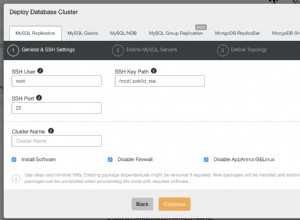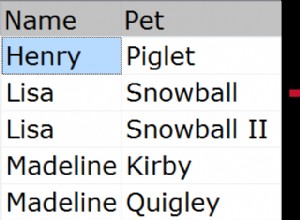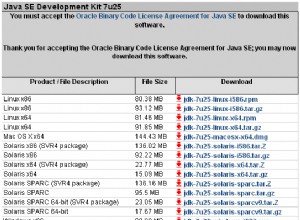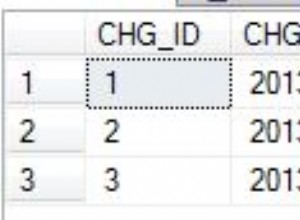Lea Please Note en la parte inferior primero. Vale, bien, has vuelto.
Creación de un procedimiento almacenado para la recuperación de jerarquías recursivas.
Tenga en cuenta que no lo quería por niveles, pero eso se puede hacer fácilmente.
Esquema:
create table category
( category_id int not null auto_increment primary key,
category_name varchar(40) not null,
parent_id int null, -- index on this column not a shabby idea
unique key (category_name)
);
insert category(category_name,parent_id) values ('car',null),('food',null); -- 1,2
insert category(category_name,parent_id) values ('ford',1),('chevy',1),('fruit',2); -- 3,4,5
insert category(category_name,parent_id) values ('economy',3),('escort',6),('exhaust',7); -- 6,7,8
insert category(category_name,parent_id) values ('chassis',7),('loud',8),('banana',5); -- 9,10,11
-- ok granted I could have explicity inserted category_id to make it more obvious
Crear proceso almacenado:
-- drop procedure showHierarchyBelow;
delimiter $$
create procedure showHierarchyBelow
(
catname varchar(40)
)
BEGIN
-- deleteMe parameter means i am anywhere in hierarchy of role
-- and i want me and all my offspring deleted (no orphaning of children or theirs)
declare bDoneYet boolean default false;
declare working_on int;
declare theCount int;
declare findFirst int;
select ifnull(category_id,0) into findFirst from category where category_name=catname;
CREATE TABLE xx_RecursishHelper_xx
( -- it's recurshish, not recursive
category_id int not null,
processed int not null
);
if isnull(findFirst) then
set findFirst=0;
end if;
insert into xx_RecursishHelper_xx (category_id,processed) select findFirst,0;
if (findFirst=0) then
set bDoneYet=true;
else
set bDoneYet=false;
end if;
while (!bDoneYet) do
-- I am not proud of this next line, but oh well
select count(*) into theCount from xx_RecursishHelper_xx where processed=0;
if (theCount=0) then
-- found em all
set bDoneYet=true;
else
-- one not processed yet, insert its children for processing
SELECT category_id INTO working_on FROM xx_RecursishHelper_xx where processed=0 limit 1;
insert into xx_RecursishHelper_xx (category_id,processed)
select category_id,0 from category
where parent_id=working_on;
-- mark the one we "processed for children" as processed
update xx_RecursishHelper_xx set processed=1 where category_id=working_on;
end if;
end while;
delete from xx_RecursishHelper_xx where category_id=findFirst;
select x.category_id,c.category_name
from xx_RecursishHelper_xx x
join category c
on c.category_id=x.category_id;
drop table xx_RecursishHelper_xx;
END
$$
Prueba de proceso almacenado:
call showHierarchyBelow('food');
+-------------+---------------+
| category_id | category_name |
+-------------+---------------+
| 5 | fruit |
| 11 | banana |
+-------------+---------------+
call showHierarchyBelow('car');
+-------------+---------------+
| category_id | category_name |
+-------------+---------------+
| 3 | ford |
| 4 | chevy |
| 6 | economy |
| 7 | escort |
| 8 | exhaust |
| 9 | chassis |
| 10 | loud |
+-------------+---------------+
call showHierarchyBelow('ford');
+-------------+---------------+
| category_id | category_name |
+-------------+---------------+
| 6 | economy |
| 7 | escort |
| 8 | exhaust |
| 9 | chassis |
| 10 | loud |
+-------------+---------------+
call showHierarchyBelow('xxx');
-- no rows
Tenga en cuenta que simplemente modifiqué esta Respuesta mío de hace unos meses para tus necesidades.
Tenga en cuenta
Lo anterior es solo para fines ilustrativos. En una situación del mundo real, nunca crearía tablas en un proceso almacenado. La sobrecarga de DDL es significativa. En su lugar, usaría tablas no temporales preexistentes con un concepto de sesión. Y límpielo de filas para la sesión finalizada. Así que no tomes lo anterior como algo más que un hombre de paja, esperando que lo hagas más eficaz como tal. Pregunte si eso es confuso.




